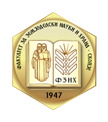ISOLATION OF PROMISING MUTANT OF ENHANCED FRUIT QUALITY IN TOMATO
Клучни зборови:
Mutation frequency, Gamma rays, EMS, Dark green fruit, TomatoАпстракт
Induction of mutation by gamma rays, ethyl methane sulfonate (EMS) and their combined treatments was studied in three widely divergent genotypes of tomato, EC-620176, EC-620177 and Patharkutchi. Combination of gamma radiation and EMS caused more damage followed by EMS treatment and gamma radiation, mainly in M1 generation. Gamma irradiation (50-150 Gy) was most efficient followed by 0.05- 0.10 % EMS and their combination treatment in inducing wide array of macro-mutation in tomato. One mutant “Dark green fruit” was isolated from the M2 population of Patharkutchi treated by 150 Gy gamma radiation. Chlorophyll ‘a’, Chlorophyll ‘b’ and total chlorophyll content in the leaf and immature fruit of this mutant was significantly higher compared to the parental genotype. Average total chlorophyll content in the leaf and immature fruit of the mutant over M3 and M4 generation was 318.52 mg/100 g fresh and 21.93 mg/100 g fresh, respectively in sharp contrast to 198.25 mg/100 g and 12.21 mg/100 g fresh, respectively in the leaf and immature fruit of the parental line. This “Dark green fruit” mutant with higher average lycopene (7.49 mg/100 g fresh) and ascorbic acid (35.86 mg/100 g fresh) contents in the ripe fruits emerged as a promising genetic resource for further utilization in tomato breeding for enhancement of lycopene and ascorbic acid content in the fruits.
Референци
Asmahan, A.A. and Al-Twaty, N. (2006). Effect of irradiation and sodium azide on some economic traits in tomato. Saudi J. Biol. Sci. 13, pp. 44-49.
El-Sayed, H.H., Abd El-Tawab, F.M. and El-Souedy, A., Sharabash, M.T and Asmahan, A.M. (1994). Effect of gamma irradiation on growth, yield and chemical constituents for three tomato varieties and their crosses. Second Arab Conference on the Peaceful Uses Energy, Cairo5-9 Nov, pp. 913-923.
Kendrick, R.E., Kerckhoffs, L.H.J., Van Tuinen, A. and Koornneef, M. (1997). Photomorphogenic mutants of tomato. Plant Cell Environ. 20, pp.746-751.
Levin, I., Frankel, P., Gilboa, N., Tanny, S. and Lalazar, A. (2003). The tomato dark green mutation is a novel allele of the tomato homolog of the DEETIOLATED1 gene. Theor. Appl. Genet. 106, pp. 454-460.
Mao, L., Begum, D., Chuang, H.W., Budiman, M.A., Szymkowiak, E.J., Irish, E.E. and Wing, R.A. (2000). Jointless is a MADS-box gene controlling tomato flower abscission zone development. Nature 406, pp.910-913.
Prem D., Gupta K. and Agnihotri A. 2011. Can we predict mutagen-induced damage in plant systems mathematically? Insights from zygotic embryo and haploid mutagenesis in Indian mustard (Brassica juncea). Botanica Serbica 35, pp. 137-143.
Sakin, M.A. and Sencar, O. 2002. The effects of different doses of gamma ray and EMS on formation of chlorophyll mutations in durum wheat (Triticum durum Desf.). Tarim Bilimleri Dergisi 8, pp. 15-21.
Van Tuinen, A., Cordonnier-Pratt, M.M., Pratt, L.H., Verkerk, P., Zabel, P. and Koorneef, M. (1997). The mapping of phytochrome genes and photomorphogenic mutants of tomato. Theor. Appl. Genet. 94, pp. 115-122.
Walter R.F., Elinor L.F. and Holly J.J. 1987. Mutation Breeding Principles of Cultivar Development, Theory and Technique. Macmillan Publishing Co. New York, pp. 287-303.



